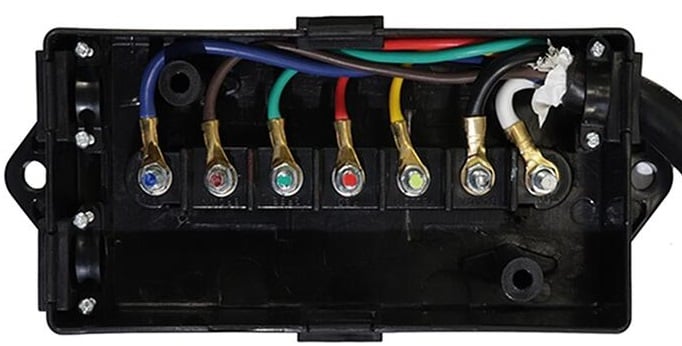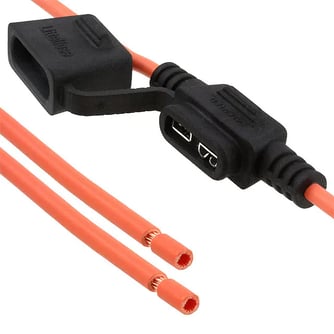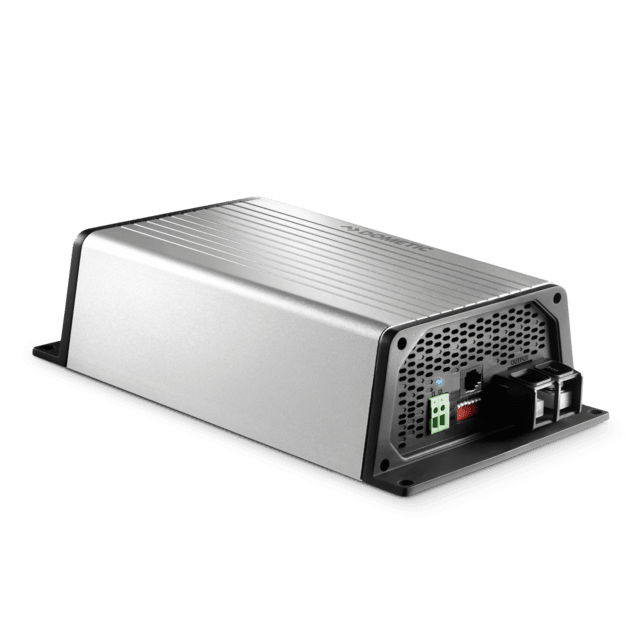Keeping your trailer batteries charged with your tow vehicle, shore power, and other options
This article details connecting the tow vehicle charging system via the 7 pin harness, and also has information on a DC/DC charger and shore power.
NOTE: AS OF JANUARY 2024, ALL TRAILERS ARE SHIPPED WITH THE 7-PIN TO BATTERY WIRING SYSTEM DESCRIBED IN THIS ARTICLE DISCONNECTED AT THE FACTORY. IT IS NOT RECOMMENDED TO HOOK THIS UP IF YOUR TRAILER HAS LITHIUM BATTERIES.
Shore Power: when not in use, it is recommended to ALWAYS keep your shore power plug connected to 110V service for both restorative and float/trickle charging year round. Refer to the owners manual for additional details.
Tow Vehicle Trickle
When plugged in, your tow vehicle's 12v electrical system will be connected to the trailer batteries via the auxiliary 7 pin lead if the trickle charge wire is connected. Most vehicles will only supply power to the auxiliary lead when the key is on - ie: the vehicle is in accessory mode or the engine is running. To check if your vehicle is charging the batteries, you can look at their voltage on the trailer's USB voltage display, or with a volt meter; when charging, the vehicle's battery will usually be more than 13 volts. Your battery voltage should increase to 13+ volts when you connect the 7 pin.
Inside of the 7 pin junction box, located between the fridge and the batteries, are wires that can be connected to the tow vehicle's charging system. On the far right, the black and white wires are both 10 AWG.

The auxiliary power pin, the black wire, is already connected to charge the battery in the emergency break away box for the electric brake system. This must never be disabled or disconnected while towing the trailer.
Instructions for hooking up the AUX wire:
Charging the trailer batteries via this auxiliary pin is up to the customer. There will be a wire from the 7-pin connector that will be fused and NOT connected to the terminal. This is up to each customer to determine if the AUX feed from the vehicle is appropriate for charging the trailer batteries. It is always recommended to use a DC-DC charger to protect the vehicle and the trailer.

Important! When using the auxiliary pin in the 7 pin box, It is not recommended to connect a vehicle with charged batteries to a trailer with discharged batteries (below 12.5 volts.) The fuse will protect the circuit, but current flow can be very high. Charge the trailer batteries first, and monitor their state of charge.
In order for the auxiliary connection to work well, grounding is also important. The connection from the ground pin in the 7 pin box to the trailer battery bank should be checked and improved if necessary. With the only connection between the vehicle and the trailer being the 7 pin connector (IE: with the trailer hitch disconnected and with the chains not in contact) continuity should be confirmed between the ground pin in the 7 pin box and the trailer's batteries. If there is a high resistance here, it is recommended that a minimum 10 gauge ground wire is run from the ground pin in the 7 pin box to the trailer frame, and to the battery bank.
All of these modifications to trailers must be vetted by the customer or their chosen installer and are not the responsibility of OGT!
DC-DC Charger
It is the recommendation of Off Grid Trailers to install a DC-DC charger between the trailer and tow vehicle. This protects both systems from potential damage.
A DC-DC charger is essential because it ensures optimal battery charging which enhances the efficiency and lifespan of the battery system. Unlike standard chargers, a DC-DC charger can effectively manage the varying input voltages from the alternator providing a stable and appropriate charge to the trailer battery. This not only enhances the reliability of the electrical system but also provides RV owners with the convenience and confidence that their power needs will be met, regardless of their location or travel conditions.
Contact our retail store if you would like to purchase a DC-DC charger for your trailer!

![OGT logo-2.png]](https://support.offgridtrailers.com/hs-fs/hubfs/OGT%20logo-2.png?height=50&name=OGT%20logo-2.png)